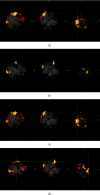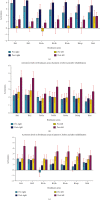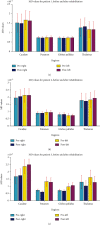A Preliminary Study of Alterations in Iron Disposal and Neural Activity in Ischemic Stroke
- PMID: 35971446
- PMCID: PMC9375706
- DOI: 10.1155/2022/4552568
A Preliminary Study of Alterations in Iron Disposal and Neural Activity in Ischemic Stroke
Abstract
Purpose: The study aimed to evaluate the postrehabilitation changes in deep gray matter (DGM) nuclei, corticospinal tract (CST), and motor cortex area, involved in motor tasks in patients with ischemic stroke.
Methods: Three patients participated in this study, who had experienced an ischemic stroke on the left side of the brain. They underwent a standard rehabilitation program for four consecutive weeks, including transcranial direct current stimulation (tDCS), neuromuscular electrical stimulation (NMES), and occupational therapy. The patients' motor ability was evaluated by Fugl-Meyer assessment-upper extremity (FMA-UE) and Wolf motor function test (WMFT). Multimodal magnetic resonance imaging (MRI) was acquired from the patients by a 3 Tesla machine before and after the rehabilitation. The magnetic susceptibility changes were examined in DGM nuclei including the bilateral caudate (CA), putamen (PT), globus pallidus (GP), and thalamus (TH) using quantitative susceptibility mapping (QSM). Functional MRI (fMRI) in the motor cortex areas was acquired to evaluate the postrehab functional motor activity. The three-dimensional corticospinal tract (CST) was reconstructed using diffusion-weighted imaging (DWI) and diffusion tensor tractography (DTT), and the fractional anisotropy (FA) was measured along the tract. Ultimately, the relationship between the structural and functional changes was evaluated in CST and motor cortex.
Results: Postrehabilitation FMA-UE and WMFT scores increased for all patients compared to the prerehabilitation. QSM analysis revealed increasing in susceptibility values in GP and CA in all patients at the ipsilesional hemisphere. By fMRI analysis, the ipsilesional hemisphere demonstrated an increase in functional activity in motor areas for all 3 patients. In the ipsilesional hemisphere, the fractional anisotropy (FA) was increased in CST in two patients, while the mean diffusivity (MD) was decreased in CA in a patient, in PT and TH in another patient, and in PT in two patients.
Conclusion: This preliminary study demonstrates that the magnetic susceptibility may decrease at some ipsilesional DGM nuclei after tDCS, NMES, and occupational therapy for patients with ischemic stroke, suggesting a drop in the level of iron deposition, which may be associated with an increase in the level of activity in motor cortex after rehabilitation.
Copyright © 2022 Abolfazl Mahmoudi Aqeel-Abadi et al.
Conflict of interest statement
The authors declare that they have no conflicts of interest.
Figures











References
-
- Anderson T. P., Greenberg F. R. Predictive factors in stroke rehabilitation . 1974. - PubMed
MeSH terms
Substances
LinkOut - more resources
Full Text Sources
Medical

